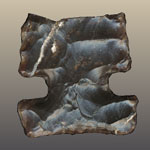Far Western is proud to present the publication of
Tufa Village (Nevada): Placing the Fort Sage Drift Fence in a Larger Archaeological Context.
By D. CRAIG YOUNG and WILLIAM R. HILDEBRANDT,
The 102nd edition of the Anthropological Papers of the American Museum of Natural History

The Fort Sage Drift Fence is one of the largest pre-Contact rock features known in the Great Basin, and appears to date between 3700 and 1000 cal B.P. When Lori Pendleton and David Hurst Thomas (1983) first recorded the 2 km long complex, they were impressed by its sheer size and the amount of labor required to build it. This led them to hypothesize that it must have been constructed, maintained, and used by specialized groups associated with a centralized, village-based settlement system—a system that was not recognized in the archaeological record at that time. Their hypothesis turned out to be quite insightful, as subsequent analyses of faunal remains and settlement pattern data have documented the rise of logistical hunting organization linked to higher levels of settlement stability between about 4500 and 1000 cal B.P. throughout much of the Great Basin. Although Pendleton and Thomas’ (1983) proposal has been borne out on a general, interregional level, it has never been evaluated with local archaeological data. This monograph remedies this situation through reporting the excavation findings from a nearby, contemporaneous house-pit village site. These findings allow us to place the drift fence within its larger settlement context, and provide additional archaeological support for the original Pendleton-Thomas hypothesis.
“Over the course of many years, long after encountering the little blue book by Pendleton and Thomas, I hiked the Fort Sage Mountains, bagging peaks, strolling along fans, and often walking the long, linear feature of the drift fence. When Bill and I had the good fortune to investigate Tufa Village—a site we’d discovered during a pipeline project—and given my occasional and long-time collaboration with Bryan Hockett and Jim Carter (and many others) on expansive constructed features like the drift fence, our thoughts soon turned to tying our ideas of Middle Archaic settlement and social patterns to a specific setting, and thereby connecting, in a way, the village with the fence. It was a pleasure to work with Bill to take the seminal work of Pendleton and Thomas another small step forward.” – D. Craig Young
The Anthropological Papers is a monograph series that has been publishing important anthropological and archaeological studies for over 100 years, continuously since 1907.
The series focuses on large-scale studies with national and international significance, geared toward a professional, scientific audience. It is distributed to every significant research library in the country, and many international facilities as well.
In one of the most prestigious outlets in the world, the publication demonstrates Far Western’s world-class research. The Anthropological Papers allows Far Western to reach a very large audience—an audience which wouldn’t be reached otherwise.
All issues of Anthropological Papers of the American Museum of Natural History are available on the web from:
http://digitallibrary.amnh.org/dspace
Order printed copies on the web from:
https://shop.amnh.org/ap102-2017-tufa-village-nevada-placing-the-fort-sage-drift-fence-in-a-larger-archaeological-context.html
or via standard mail from:
American Museum of Natural History—Scientific Publications
Central Park West at 79th Street
New York, NY 10024














